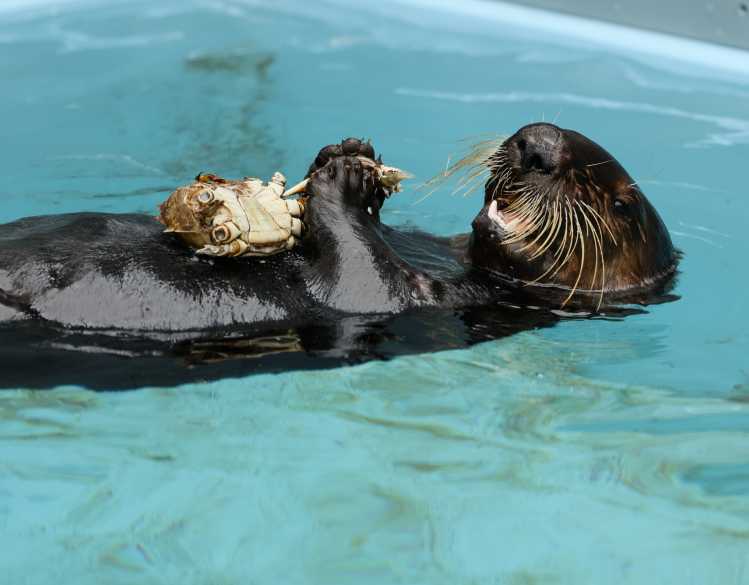
What Do Sea Otters Eat? And Other Otter Trivia
- Species conservation
- Natural history
You already know sea otters are cute and charismatic, but how well do you know your sea otter facts? From a sea otter’s diet and habitat to unique adaptations, take a deep dive into this trivia! Plus, see how you can be part of critical conservation efforts to protect these animals.
Southern sea otters are a threatened species, so the survival of each individual otter is crucial to the future of this population. As the world’s largest marine mammal hospital, The Marine Mammal Center is able to take what we learn from the hundreds of animals we rescue each year to help us better understand how to protect our ocean and marine mammals like the southern sea otter.
Ready to put your knowledge to the test? Click “Show More” to reveal the answer and more facts about sea otters.

What do sea otters eat?
As one of the few animals that use tools, sea otters mostly feed on shelled creatures like urchins, crabs, clams and abalone, using a rock to break them open. In a single day, they can eat 25 to 30 percent of their body weight!
Did you know that a sea otter’s diet helps fight climate change? Sea otters are a keystone species, which means they are essential to maintaining a healthy ecosystem. As top predators, they help control populations of purple sea urchins—which are voracious kelp grazers—so that kelp forests can flourish. And not only do these thriving kelp forests provide habitat to other species, but they’re also very efficient in capturing carbon dioxide, which strengthens our natural defenses against climate change.
How many hairs per square inch does a sea otter have?
With nearly 1 million hairs per square inch, sea otters have the densest fur of any animal.
Why do sea otters need so much fur? Without blubber to protect them from chilly ocean waters, they rely on this adaptation to keep warm and survive. In fact, sea otters have two layers of hair that trap air and keep their skin dry. But their fur loses its insulating qualities if exposed to oil, putting them at risk of oil spills. As part of the Oiled Wildlife Care Network, our hospital acts as a primary response facility during a large spill to make second chances possible.
Other threats sea otters face include infectious diseases and parasites, shark bites, maternal separation, boat strikes and entanglement. Thanks to support from people like you, our experts are providing life-saving care to southern sea otters and conducting vital research to better protect this threatened species.
You can help the next otter in need when you adopt a past patient.


Where do sea otters live?
The threatened population of about 3,000 southern sea otters can be found in nearshore waters along California’s central coast, from Half Moon Bay to Point Conception. There is a much larger population of sea otters in Alaska, and some still live in in Russia as well.
Before they were hunted to the brink of extinction for their luxurious fur, sea otters once lived along the entire North Pacific Rim from Japan to Baja California, Mexico. The U.S. Fish and Wildlife Service recently assessed the feasibility of reintroducing sea otters to their historical range in Northern California and Oregon. Not only is reintroduction biologically possible, but it may help the recovery of the threatened southern sea otter and restore vital kelp ecosystems—having a ripple effect that could benefit a variety of marine species and coastal communities.
Adopt a past sea otter patient to give current and future patients a second chance at life!
Exclusive digital download!

Yes, I want to save a life!

Yes, I want to save a life!
You’ll be giving sick and injured animals the best possible care at the Center’s state-of-the-art hospital. With your gift today, you are giving a patient a second chance at life in the wild.
See Our Latest News
{"image":"\/People\/Action\/Veterinary care\/cropped-images\/Harris_Green turtle_TMMC-0-0-1270-992-1767649941.jpg","alt":"Heather Harris","title":"Seattle Aquarium Awards Dr. Heather Harris With Prestigious Conservation Research Award","link_url":"https:\/\/www.marinemammalcenter.org\/news\/seattle-aquarium-awards-dr-heather-harris-with-prestigious-conservation-research-award","label":"In the News","date":"2026-01-05 04:48:00"}

Seattle Aquarium Awards Dr. Heather Harris With Prestigious Conservation Research Award
January 5, 2026
Read More{"image":"\/People\/Action\/Veterinary care\/cropped-images\/harris-teaching-tube-feeding-0-0-1270-992-1767650122.jpg","alt":"A veterinarian and two trained volunteers tube feed an elephant seal pup.","title":"Training College Students in Marine Mammal Health","link_url":"https:\/\/www.marinemammalcenter.org\/news\/training-college-students-in-marine-mammal-health","label":"News Update","date":"2026-01-05 04:48:00"}

{"image":"\/Animals\/Patients\/Harbor seals\/2013\/cropped-images\/hs-bogey-photo-by-Ingrid-Overgard-c-the-marine-mammal-center-382-0-2914-2276-1605061447.jpg","alt":"harbor seal Bogey","title":"Top Eco Friendly Valentine\u2019s Day Gifts","link_url":"https:\/\/www.marinemammalcenter.org\/news\/top-eco-friendly-valentines-day-gifts","label":"News Update","date":"2026-01-01 01:00:00"}

{"image":"\/Animals\/Patients\/Harbor seals\/2020\/cropped-images\/hs-barnwood-by-bill-hunnewell-c-the-marine-mammal-center-315-0-3299-2577-1607370547.jpg","alt":"harbor seal Barnwood","title":"Last-Minute Gift Guide \u2013 Top Gifts that Give Back to Marine Animals","link_url":"https:\/\/www.marinemammalcenter.org\/news\/last-minute-gift-guide","label":"News Update","date":"2025-12-18 01:00:00"}

Last-Minute Gift Guide – Top Gifts that Give Back to Marine Animals
December 18, 2025
Read More






